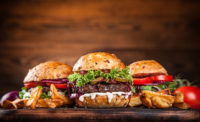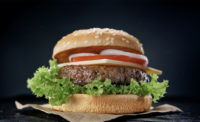The state of the burger category remains strong as shown by the continued emergence and growth of burger-specific concepts such as Five Guys, Smashburger and The Burger Joint.
Furthermore, burgers are available on 52.2 percent of all restaurant menus, notes Datassential’s MenuTrends’ Burger Overview report, showing up at 60.6 percent of casual, 56.6 percent of fine dining, 52.5 percent of midscale and 41.3 percent of quick-service restaurants.
“According to Mintel’s Menu Insights, the number of burgers menued across commercial foodservice grew 4 percent from Q4 2011 to 2014,” says Bethany Wall, foodservice analyst, for Chicago-based Mintel research firm. “Restaurant segments experiencing growth include quick-service (12 percent) and fine dining (13 percent). This shows the versatility of burgers in that they can just as easily serve as a comfort food as they can an upscale, gourmet-like offering.”
Indeed, 69 percent of consumers visited a limited-service burger restaurant in the past month, she says, of which 15 percent said they went to the burger restaurants more than they did last year.
“The fast-casual segment like Five Guys is growing and cannibalizing share from fast food,” says Darren Tristano, executive vice president, Technomic, a Chicago-based research firm. “As they grow, fewer consumers will go to McDonald’s, Wendy’s and Burger King, for example.”
In particular, the more affluent or Millennial consumer will go to a Smashburger, because they are willing to pay for quality, he says.
“This consumer is willing to pay $10 a meal, so they are looking at the fast-casual segment, whether it’s at Panera, Chipotle or Five Guys,” says Tristano.
Keeping margins up
The popularity of burgers recently has been aided by rising beef prices, forcing restaurants to look for creative ways to keep healthy margins, such as reducing portions, offering other types of protein and selecting less expensive cuts of beef such as ground beef, says Wall.
If restaurants use lower-priced ground beef, they can elevate it with unique toppings and flavor pairings, she says.
“Infact, 47 percent of consumers would be willing to pay more for premium toppings,” says Wall. Another strategy is to use high-quality ground beef to appeal to health-conscious consumers.
“Burger consumers (78 percent) don’t mind waiting for food if it is high quality,” she says.
According to Mintel’s “Limited Service Restaurants: Burger, Chicken and Seafood Concepts – US” 2014 report, about half of ingredients listed on menus highlight preparation claims. Of those, consumers prefer to order cut (16 percent), ground (9 percent), patty (9 percent), fried (7 percent) and grilled (6 percent) ingredients off burger menus.
Customizing orders
Burger King might have been on tosomething with its long-running “Have it Your Way” campaign (which was changed to “Be Your Way” last year). Consumers today are happy to customize their burgers at restaurants — and pay for the privilege.
“Many of these concepts fall under the fast-casual restaurant segment, using higher-quality ingredients and offering guests the opportunity to customize menu items,” says Wall.
In fact, 83 percent of consumers like choosing their own toppings for burgers and 22 percent of burger diners increased the amount they customized compared to last year, according to Mintel’s Burger, Chicken and Seafood report.
“Customization allows consumers to pick and choose everything from the type of bun and meat to sauces and toppings,” says Wall. “This helps provide a range of offerings from healthful to indulgent and can easily accommodate guests with dietary restrictions.”
In addition, the customization strategy helps streamline menus, which cuts down on food waste and boosts operational efficiencies, she says.
The Tavern Restaurant Group (TRG) is testing this theory with its streamlined burger program, which was introduced within the past year. The upscale gastropub got rid of its 16 signature burgers and installed a “DIY approach” instead, allowing customers to pick their protein (Angus beef, ground turkey, ground lamb, chicken breast fillet or black bean patty) and four finishing options that group the type of bun, toppings and condiments together.
The goal is for consumers to enjoy a unique experience that they won’t find at another fast-casual restaurant.
McDonald’s is getting in on the customization trend with its “Create Your Taste” program, trying to reverse declining same-store sales and appeal to younger consumers who have shown to be inclined to visit fast-casual restaurants with custom menus such as Panera, Five Guys or Chipotle.
The expanding pilot program (2,000 locations this year) allows customers to choose their protein, bun, toppings and sauces on a tablet-like kiosk. They give up some speed of delivery for ownership of their burger.
Restaurants are also being creative in their ability to make burgers profitable by offering burgers with different price points.
Utilizing alternative proteins
“We’ve seen an increase in nontraditional proteins, such as veggie and turkey,” says Stacie Sopinka, vice president of product development, US Foods, Rosemont, Ill. “At US Foods, we recently launched an all-natural turkey burger, for example, with ingredients like mushrooms and tomato powder.”
Veggie burgers are becoming more popular and sophisticated, as new sub segments are created such as mushroom, soy and bean-based burgers; whereas before there was just one, says Sopinka.
“The move away from beef to alternative proteins is driven by price and health, and we will continue to see this trend,” she says. “We launched the Harvest Value Savory Burger recently as a joint venture of vegetables and beef, as one third is made with mushrooms. They have a flavor and texture similar to beef, plus 40 percent less fat.”
The focus on quality and health is also reaching burgers’ ingredients. Recently, McDonald’s announced that within two years it would only use antibiotic-free chicken, prompting renewed interest in hormone and antibiotic-free burgers.
“We will also see free-range and grass-fed beef become more popular,” notes Tristano. “Consumers aren’t as used to the flavor of grass-fed beef today, but indulgence, taste and quality ingredients will continue to evolve.”
Upscaling combinations
The premiumization of burgers, says Sopinka, can occur via any of three different aspects: premium beef is no longer just Angus but grass-fed or local meat; how it’s produced becomes important (if it’s tartare, the grind or its percentage of being lean); and everything outside the burger like the toppings and bun.
“Cheddar might have been the top cheese before, but now blue cheese is outranking it and provolone is becoming popular,” says Sopinka.
Other toppings on the menu are fried eggs, specialty bacon, caramelized onions, homemade chutney and peppers.
“It allows operators to charge more and is driven by Millennials who look at customization like the Chipotle model,” she says.
Buns are also becoming more creative with ciabatta, whole grain and potato buns — and even donuts — serving as the carrier for the protein and toppings. Running at the other end of the spectrum from healthy, vegetarian options, some restaurants are opting to serve other radical, over the top combinations, Sopinka says.
Slater’s 50/50 in Anaheim Hills, Calif., serves the Peanut Butter and Jealously burger — highlighting a growing trend to use peanut butter as a condiment. Atlanta’s Flip Burger sells a raw tartare tuna burger with tri-colored seaweed, wasabi tobiko, macadamia nuts, kewpie mayo, sesame seeds and, for a little more rawness, a raw egg on top. In Las Vegas, the Burger Bar offers a $60 decadent Kobe beef burger with foie gras, truffles and truffle sauce.
“We have a Chef’s Line burger that is from whole-muscle cuts, so it’s super-succulent and decadent,” says Sopinka.
Of course, sometimes there can be too much of a good thing, so restaurants are also offering smaller portions to appeal to the current grazing, tapas mentality of sampling different foods, she says.
“Also, we may see burgers being served on just lettuce, not buns,” she says.
Hot trends in retail frozen aisle
In the frozen aisle, dollar sales for burgers are demonstrating continued growth year over year and are currently up approximately 3 percent, says Sara Shenoha, brand manager of Ball Park Brand in Chicago.
“Much of this growth is driven by the pre-cooked segment, comprised of burgers and patties that have been fully cooked and may be prepared in the microwave, in addition to the traditional preparation methods [i.e. grilling, stove top, skillet, etc.],” she says.
These pre-cooked burgers are offering consumers the opportunity to enjoy the great taste of the grill, but help save on prep and clean-up time, says Shenoha.
“They also make it possible to enjoy the taste of a grilled burger during times of the year when grilling outdoors is limited due to colder temperatures,” she says.
Consumers expect burgers at the grocery store to also provide cleaner labels and include claims such as “made with all-natural ingredients” and “no artificial preservatives.”
“We are also seeing an increase in the number of gluten-free products available,” says Shenoha. “Our line of Ball Park Flame Grilled Beef and Turkey Patties helps meet this growing need as they contain no flavors [and] no byproducts and are gluten-free.”
Despite an increase in price due to higher beef costs, shoppers are still opting to choose a higher-quality beef product.
“Consumers are also looking for bolder, thicker and juicier burgers that mimic the grilling experience, but take less time to prep and cook,” says Shenoha.
Burger sliders are also being used as an appetizer option, she says.
“In terms of toppings and flavors, bacon continues to be a strong trend with consumers adding bacon to just about everything, including their burger,” she says. “Ball Park Brand offers a Flame Grilled Beef and Cheese with Bacon Patty which plays off this trend.”
Also, poultry, particularly chicken, has been growing as new, bold flavors are introduced, overcoming “chicken boredom” and helping drive trial of a new protein outside of beef, says Shenoha, as Ball Park Brand is launching Chicken Patties soon.
Standing out from the crowd
Each consumer has his or her own criteria when it comes to burgers. However, restaurants and retailers will need to stand out and differentiate themselves from competitors in order to drive traffic and frequency of visitation.
“The largest opportunity I see is offering authentic, signature items,” says Wall. “Over half of burger consumers are interested in traditional items with an ethnic twist, while an equal number prefer regional items that are authentic.”
With increasing globalization, we will see more “mash ups” of international flavors and ingredients with burgers, says Sopinka.
“A good burger is hard to beat,” she says. “It’s a great value equation relative to steak. It’s portable, customizable and uniformly delicious, and it will continue to evolve.”











Report Abusive Comment